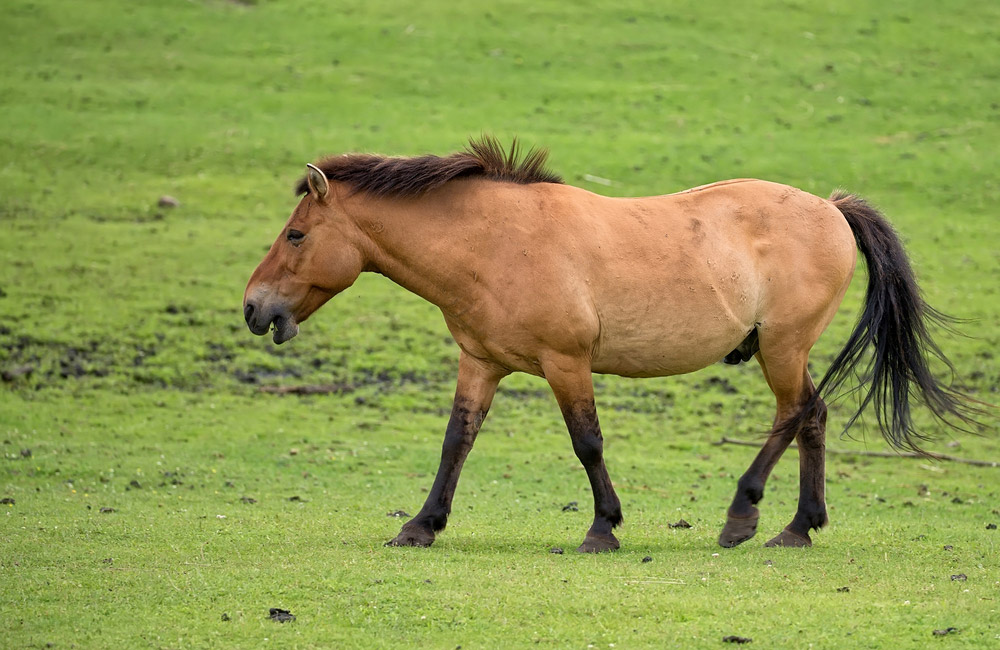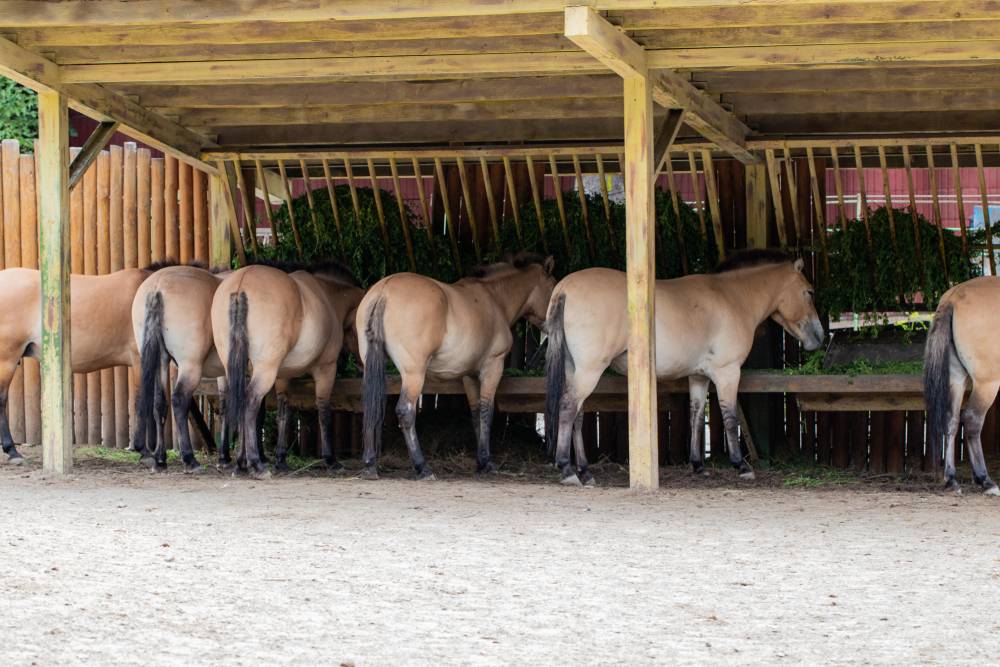
Przewalski’s Horse is a rare and endangered horse originally native to Mongolia. But the endangered species is about to become extinct. Most wild horse herds are located in the wild in Central Asia. Such an animal is commonly seen as a wild horse. Here’s a detailed overview of Przewalski’s breed with interesting facts included.
What Is a Przewalski Horse?
Przewalski’s Horse is 12 to 14 hands tall on average. The average weight is 660 pounds. Przewalski’s Horses commonly have a coat of a dun color. The mane and tail are brown, varying color tints. Przewalski’s Horse is easily recognized by its faintly striped legs and white belly.

Przewalski’s Horse History
First records of wild horses with Przewalski’s conformation trace as back as 20,000 years ago. But there are still no strong proofs linked to Przewalski’s Horse. Early sources mentioned Przewalski’s Horses in the Chalcolithic Botai culture. Thus, the horse breed occurred from 3000 BCE.
The breed is named after the Russian explorer Nikołaj Przewalski. In 1881, the horse was named Equus Przewalski or Equus Ferus Przewalskii. During the 19th century, the breed was captured and explored. Some representatives were kept in the zoos. This helped to promote the breed and be safe from extinction.
Several expeditions took place in 1955 and 1962 to look for Przewalski’s Horse herds. A few representatives were found in the result. The horse was marked as extinct in the wild for more than 30 years. Military needs, hunting, and zoo capture were the main reasons that affected the breed’s population decline.
Attempts to keep captive breeding failed until 1902. 28 foals were imported to Europe at that time. The captives were spread among zoos and breeding centers in the United States and Europe. Most of the captive programs have failed but some of them were successful. By the 1930s, captive breeding has declined immensely. Another downturn was caused by World War II. When lots of equines were abandoned and slaughtered.
During that time, only two captive herds survived. Those were zoo groups in Munich and Prague. Eventually, only 12 Przewalski’s horses had survived in the zoos by the 1950s. In the late 1960s, the horse breed started to revive to hold 130 individuals in 32 zoos.
There were specialized reserves focused on preserving the Przewalski’s Horse as well. One of the most notable is the Askania Nova in Ukraine. In 1998, 31 equines were brought to the Chernobyl Exclusion Zone in Ukraine. This led to raising the population to more than 100 representatives of the breed in that zone. Such equines are typically not used to be ridden under a saddle.

Another significant place to keep Przewalski’s Horses is Le Villaret in southern France. The site is held way to provide a natural condition for the horse breed. In 1993, 11 representatives were imported to Le Villaret. They live there in the wild being able to mate and look for forage on their own.
In 2011, the project named “Return of the Wild Horses” was launched by Prague Zoo. The point is to keep the breed and reintroduce horses to Mongolia. Thus, the process of reintroduction of Przewalski’s Horses has started. The equines are imported to the Great Gobi B Strictly Protected Area in Mongolia.
In 2016, the reintroduction of Przewalski’s Horses started in Russia. The horses were imported into the Orenburg region. All of these affected the breed’s population. Eventually, Przewalski’s Horse status turned from “extinct in the wild” to “endangered“.
The Przewalski’s Horse is also known as the first cloned horse breed. Supporter by the North American breeding program, artificial insemination took place in 2013. As a result, the first cloned horse was born in 2020. The cell donor was a Przewalski’s stallion named Kuporovic foaled in 1975. He was born in the UK and imported to the US in 1978 where he lived until he died in 1998. Kuporovic’s tissue was cryopreserved to wait for technology development.
Eventually, the first horse clone was born in the 21st century. It was named Kurt after the German-American geneticist Dr. Kurt Benirschke. Once Kurt grew up, he was imported to the San Diego Zoo. The horse took part in breeding to produce foals with his genes. This led to genetic variation of the equine.

Przewalski’s Horse Habitat
The native origin of Przewalski’s Horse is the Mongolian steppes of the Gobi Desert. The region features not only sands but grasslands too. Thus, the breed is also known as the Mongolian wild horse or Takhi (“spirit”). There are areas with forests and mountains as well. Mongolia is a region of extreme weather conditions. The temperature in summer may go up to 104° Fahrenheit. While it’s 50° Fahrenheit below zero in winter.
Przewalski’s Horses have claimed the only wild horses left in the world. They are kept in natural wild conditions in their habitat. In contrast, Mustangs are feral horses descended from domesticated horses. The wild population of Przewalski’s Horse has almost disappeared with some wild Przewalski’s horses kept for breeding programs and zoos worldwide.
Mares and their foals typically live in a family group, headed by a dominant stallion. After enduring 11-12 months of pregnancy, mares will give birth to a foal. Foals begin grazing within only a few weeks after entering the world. Nursing continues for 8-13 months before females remain with the herd while stallions are forced out shortly thereafter.

The Taxonomic Position of Przewalski Horses
Taxonomists have long debated the origin of Przewalski’s horse (Equus ferus przewalskii) with two main positions on its classification. Supporters claim it is a wild horse, while opponents indicate that humans have been selectively breeding this species for generations and thus consider it to be domesticated.
There are taxonomists treating Przewalski’s horse as a wild breed citing several convincing pieces of evidence. Firstly, this particular strain has never been tamed unlike domestic horses, and it evinces typical characteristics connected with untamed equines. These include feverish reactions once threatened and an aptitude to flourish in arid conditions. Molecular analysis reveals that its DNA is dissimilar from modern domestic horses, signifying that these two types have been genetically isolated for many years now.
Proponents of the Przewalskis being domesticated animals point to its centuries-long history of selective breeding by humans. As well as the equine’s docile temperament and readiness for human handling. They also emphasize that the breed has been engaged in various activities such as racing or riding. Thus, further legitimizing their argument about its status of a domestic horse.
Taxonomists are divided on this subject, yet the majority currently group Przewalski’s horse as a subspecies of Equus ferus. However, not everyone agrees with this view and some assert that it must be viewed as an entirely different species.

Przewalski’s Horse Characteristics
Przewalski’s Horse is stocky and compact. The body is short and of a heavy build. Such horses are smaller than domesticated equines. The head is large with a thick neck. The profile is convex. The dock is long. The legs are short. The hooves are longer on the frontline. The sole horns are thicker to adapt to harsh terrains.
Przewalski’s Horses are commonly dun in color. The mane is dark and short that stands up. The horse’s tail goes up to 35 inches long. The area around the mane is dark brown. While the flanks are light brown. There’s a dark line from the mane to the tail. The muzzle is white while the belly is also yellowish-white. Przewalski’s Horses may have primitive markings. The breed stands out with zebra-striped legs behind the knees. The lower limbs are of a darker color.
The lifespan of Przewalski’s Horse is 25 to 35 years. That is pretty solid.
Przewalski’s Horse Size
Przewalski’s Horse height is 12 to 14 hands tall on average. It weighs around 550 to 800 pounds. That is less than an average domesticated horse breed. For instance, a Hackney Horse is 14.2 to 16.2 hands tall.
Przewalski’s Horse Price
Modern Przewalski’s horses are a rare and endangered species, so buying or selling these animals is not allowed due to their illegality in many countries like Mongolia where they originate. This means there isn’t an average market price for them as it would be against the law to do so.

Przewalski Horse Explored
Przewalski’s Horse is a truly wild horse that is struggling to survive. Several preserves around the globe keep the horse breed to increase the population. This helps to promote the horse and keep it away from the “extinct” status. Przewalski’s Horses are wild equines that look for forage and water supply on their own.
This is a fascinating horse breed that is easily recognized. Przewalski Horses are dun equines with brown short upstand mane and long tail. They have a white muzzle and belly. Zebra stripes on the legs are very attractive. Preservations are working hard to reintroduce the breed to its natural habitat in Mongolia.
